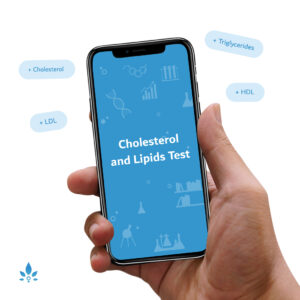The Link Between Obesity and Cancer in Women


Global obesity rates are rising at an alarming rate. Across parts of the Middle East, obesity prevalence rates are as high as 40% and, with poor dietary habits and insufficient physical activity across the region, these rates are unlikely to decline any time soon. Obesity is associated with a myriad of health problems, including type 2 diabetes mellitus (T2DM), high blood pressure, cardiovascular disease, stroke, premature death and cancer.
Obesity has been linked to an increased incidence of various cancers, including:
- Meningioma
- Thyroid
- Oesophageal
- Breast
- Multiple Myeloma
- Liver
- Kidney
- Gall bladder
- Stomach
- Endometrium
- Ovary
- Pancreas
- Colorectal
Try Nabta’s Cholesterol and Lipids Test to manage your weight and try using our Cancer Luxury Selfcare Pack, and Cancer Luxury Selfcare Add-Ons for Women for cancer care.
In fact, a large scale, population-based study revealed that in 2012, approximately 3.6% of all adulthood cancers could be attributed to obesity. This made obesity the second leading risk factor for cancer after smoking. Cancer mortality increases with a higher BMI and those who are obese are between 40% and 80% more likely to die from cancer.
This article aims to explore the link between obesity and female gynaecological cancers in more detail. However, as demonstrated by the list above, the problem is far more extensive than this; having a high BMI will increase your risk of developing many different types of cancer. Therefore, if you are overweight or obese, it is imperative that you make reducing your BMI a priority.
Gynaecological Cancers
- Endometrial, or womb cancer is a type of cancer that develops in the cells lining the uterus. A link between obesity and endometrial cancer was first identified in the 1960s and it is now thought that women who are obese or overweight are 2 – 4 times more likely to develop this type of cancer. In those who are extremely overweight, the risk can be as high as 7-fold higher.
- Ovarian cancer. A 5 unit increase in BMI is associated with a 10% increased risk of ovarian cancer.
- Breast cancer. A 5 unit increase in BMI is associated with a 12% increased risk of breast cancer in postmenopausal women. Those who are obese are considered to have a 20 – 40% increased risk of developing breast cancer. They will also have a worse prognosis at diagnosis and increased chance of metastatic disease.
Why does obesity increase your risk of developing cancer?
Two of the main factors that are thought to link obesity to gynaecological cancer are hormonal changes and inflammation.
Oestrogens are synthesised from androgens by the enzyme aromatase. In healthy, premenopausal women most of this conversion occurs in the ovaries and the oestrogen that is produced regulates the menstrual cycle. After the menopause, the ovaries no longer synthesise oestrogen; however, production of this hormone continues at distal sites, including within adipose (fat) tissue. In fact, one of the major sites of oestrogen synthesis in the postmenopausal female is the adipose tissue, which has high levels of aromatase. Obese females have more adipose tissue, resulting in an increase in unopposed circulating oestrogens. This can have beneficial effects with regards to maintaining bone strength (reducing the risk of osteoporosis), but it also increases the risk of endometrial hyperplasia (a precursor of endometrial cancer) and oestrogen-dependent breast cancer.
Obesity is considered to be a state of chronic, low-grade inflammation. This proinflammatory state is thought to trigger DNA damage and promote an oncogenic environment for the proliferation of cancer cells. Specifically, inflammation promotes tumour initiation and progression. Adipose tissue also produces adipokines, which can exert proliferative effects on tumour cells, as well as targeting other cell growth regulators. The net effect being an environment that, given the right conditions, can contribute to tumour development.
With regards to breast cancer, recent studies have attempted to probe the microenvironment of breast adipose tissue in more detail. It was found that obesity leads to mechanical niches in adipose tissue, which promotes carcinogenesis. Altered tissue structure can increase the malignant capabilities of mammary cells, providing one possible explanation for why obese breast cancer patients tend to have a significantly worse prognosis.
Type 2 diabetes, obesity and cancer
There is a strong association between obesity, T2DM and cancer and it is likely that multiple metabolic abnormalities contribute to the increased risk of cancer in those with T2DM.
Hyperinsulinaemia is a symptom of T2DM, characterised by an excess of circulating insulin. It is not unique to patients with T2DM, but is strongly associated with the condition. With increasing BMI, there is a linear increase in the levels of circulating insulin. This means that the body’s tissues become resistant to insulin and the body compensates by producing more. High levels of insulin have been shown to promote the development of certain cancers, including endometrial cancers. There is also a strong positive relationship between insulin resistance and postmenopausal breast cancer, potentially due to insulin having a direct effect on the levels of sex hormones, including oestrogen. Insulin receptors are also highly expressed in tumours of the breast.
Postmenopausal women with T2DM have a 17% increased risk of developing breast cancer. Furthermore, it has been shown that Metformin treatment, used regularly in the management of T2DM, exerts a protective effect, reducing the risk of breast cancer in postmenopausal women with diabetes. Additional studies have shown that mortality rates for both breast cancer and endometrial cancer are higher in those women with concurrent T2DM.
It is important to note that women with type 1 diabetes do not demonstrate the same increased risk of developing cancer.
Final comments
The relationship between obesity and cancer is a complex one and the exact nature of the physiological events that link the two, remains to be fully elucidated. As has been alluded to in this article, it likely involves the interplay of various factors, including hormones, growth factors, inflammation and structural tissue changes. Insulin resistance seems to play a pivotal role in the etiology of obesity-associated cancer.
Whilst there is evidence that those who gained less weight during adulthood have a lower risk of developing breast, endometrial and ovarian cancer (as well as colon and kidney cancer); there is little evidence that intentional weight loss improves recurrence rates or prognosis for those who have already been diagnosed with cancer.
Another topic that requires further attention is whether being obese can affect the efficacy of the most widely used cancer treatments. It is known that obese patients have a less diverse gut microbiome, which may contribute to increased inflammation. However, preliminary studies in mice also suggest that changes in the microbiome might affect the immune response to treatment. This is a theory that requires validation using human subjects, but provides one explanation for why patients respond differently to treatment.
Nabta is reshaping women’s healthcare. We support women with their personal health journeys, from everyday wellbeing to the uniquely female experiences of fertility, pregnancy, and menopause.
Get in touch if you have any questions about this article or any aspect of women’s health. We’re here for you.
Sources:
- Arendt, Lisa M., and Charlotte Kuperwasser. “Working Stiff: How Obesity Boosts Cancer Risk.” Science Translational Medicine, vol. 7, no. 301, 19 Aug. 2015, doi:10.1126/scitranslmed.aac9446.
- Arnold, Melina, et al. “Global Burden of Cancer Attributable to High Body-Mass Index in 2012: a Population-Based Study.” The Lancet Oncology, vol. 16, no. 1, Jan. 2015, pp. 36–46., doi:10.1016/s1470-2045(14)71123-4.
- Calle, Eugenia E, and Michael J Thun. “Obesity and Cancer.” Oncogene, vol. 23, no. 38, 23 Aug. 2004, pp. 6365–6378., doi:10.1038/sj.onc.1207751.
- Col, Nananda F., et al. “Metformin and Breast Cancer Risk: a Meta-Analysis and Critical Literature Review.” Breast Cancer Research and Treatment, vol. 135, no. 3, Oct. 2012, pp. 639–646., doi:10.1007/s10549-012-2170-x.
- CONFRONTING OBESITY IN THE MIDDLE EAST: Cultural, Social and Policy Challenges. The Economist, Oct. 2016, https://eiuperspectives.economist.com/sites/default/files/ConfrontingobesityintheMiddleEast_0.pdf.
- Gallagher, Emily Jane, and Derek Leroith. “Obesity and Diabetes: The Increased Risk of Cancer and Cancer-Related Mortality.” Physiological Reviews, vol. 95, no. 3, July 2015, pp. 727–748., doi:10.1152/physrev.00030.2014.
- Ligibel, Jennifer A., and Howard D. Strickler. “Obesity and Its Impact on Breast Cancer: Tumor Incidence, Recurrence, Survival, and Possible Interventions.” American Society of Clinical Oncology Educational Book, vol. 33, 2013, pp. 52–59., doi:10.1200/edbook_am.2013.33.52.
- “Obesity and Cancer Fact Sheet.” National Cancer Institute, https://www.cancer.gov/about-cancer/causes-prevention/risk/obesity/obesity-fact-sheet#r48.
- Seo, Bo Ri, et al. “Obesity-Dependent Changes in Interstitial ECM Mechanics Promote Breast Tumorigenesis.” Science Translational Medicine, vol. 7, no. 301, 19 Aug. 2015, doi:10.1126/scitranslmed.3010467.
- Sivan, A., et al. “Commensal Bifidobacterium Promotes Antitumor Immunity and Facilitates Anti-PD-L1 Efficacy.” Science, vol. 350, no. 6264, 27 Nov. 2015, pp. 1084–1089., doi:10.1126/science.aac4255.
- Stocco, Carlos. “Tissue Physiology and Pathology of Aromatase.” Steroids, vol. 77, no. 1-2, Jan. 2012, pp. 27–35., doi:10.1016/j.steroids.2011.10.013.
- Stone, Trevor W., et al. “Obesity and Cancer: Existing and New Hypotheses for a Causal Connection.” EBioMedicine, vol. 30, Apr. 2018, pp. 14–28., doi:10.1016/j.ebiom.2018.02.022.













































